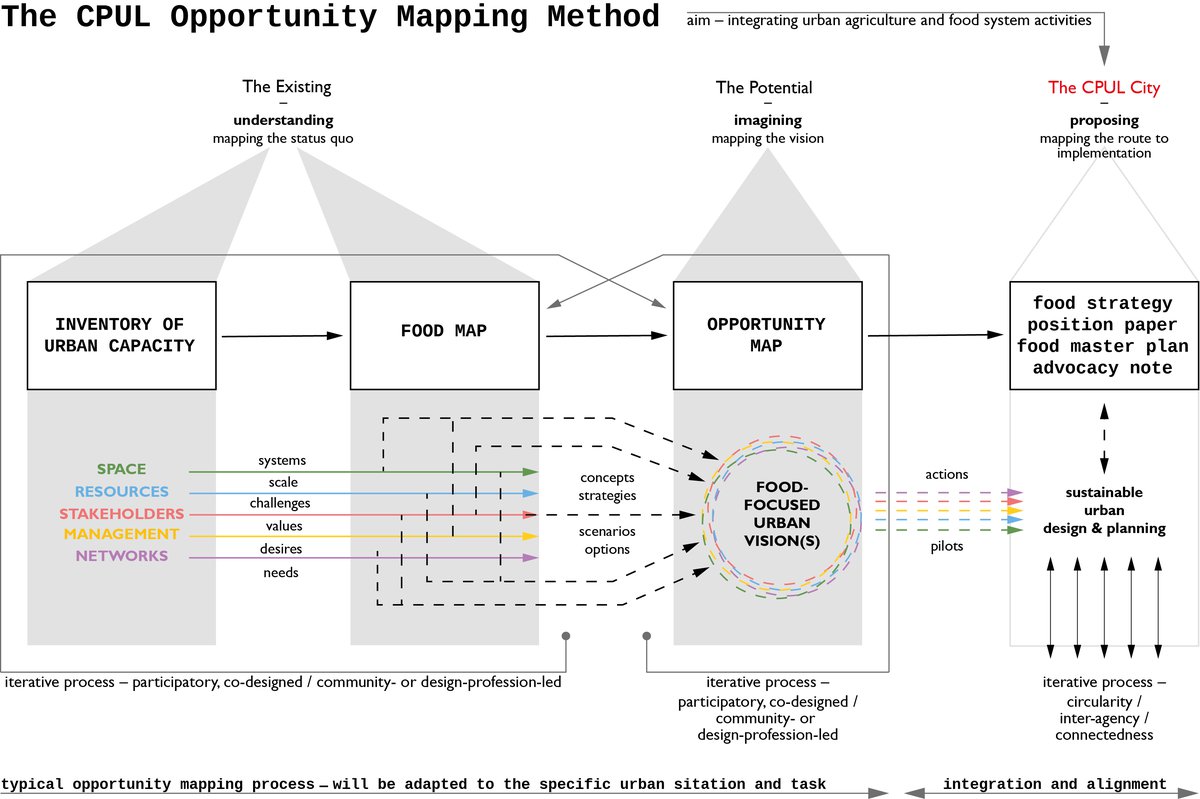2023-Nov-30 : Coming soon: A book chapter on urban design for food
One of the contributions to Bohn’s and Tomkins’ edited volume Urban Food Mapping: Making visible the Edible City will be Katrin’s chapter on food opportunity mapping. It is in production since this month and will be out in Spring 2024 (Routledge).
Fully titled Food in urban design and planning: The CPUL Opportunity Mapping Method, the chapter starts of from the observation that sustainable urban food planning is still largely missing from urban design debates. It then presents Bohn&Viljoen’s conceptual work on “mapping food” and “mapping food opportunities” as one of the solutions to rectify this omission. Katrin’s chapter introduces the CPUL Opportunity Mapping Method and concludes by presenting two case studies that used this method to conduct participatory food systems planning.
Fully titled Food in urban design and planning: The CPUL Opportunity Mapping Method, the chapter starts of from the observation that sustainable urban food planning is still largely missing from urban design debates. It then presents Bohn&Viljoen’s conceptual work on “mapping food” and “mapping food opportunities” as one of the solutions to rectify this omission. Katrin’s chapter introduces the CPUL Opportunity Mapping Method and concludes by presenting two case studies that used this method to conduct participatory food systems planning.

The CPUL Opportunity Mapping Method explained (image: Bohn&Viljoen Architects [2012] with Ian Bailey, University of Brighton, 2021)
Here the chapter's abstract:
Until about 20 years ago, food was missing from urban design and planning debates. Certain interventions, such as fresh-food markets or school meals, have since experienced considerable attention. However, the significance of the entire food system, esp. of food production and food waste recycling, for sustainable urban development is still largely overlooked.
This essay explores the relationships between “mapping food” and “mapping food opportunities” in spatial planning and urban design. Drawing on two examples from the author’s work – one in Cologne (Germany), the other in Carthage (Tunisia) -, it reflects on a practice-based method to generate food-focused opportunity maps as part of participatory urban design and planning processes. The method is rooted in the Continuous Productive Urban Landscape (CPUL) design concept and provides stakeholders in food planning procedures with a tool for the coherent integration of urban agriculture and food system activities spatially, into the local fabric, as well as strategically, into local planning policy.
By comparing the urban food maps generated in Carthage and Cologne, the essay explains the opportunity mapping method in its three stages: The creation of Inventories of Urban Capacity (stage 1) and of urban food maps (stage 2) as communication tools enable a systematic recording and visualisation of existing local food system spaces, stakeholders, resources, networks and management. The mapping process then focusses on the multiple opportunities (stage 3) that specific food system activities can bring to certain sites or cities. The chapter concludes with suggestions on how and where these opportunities can initiate or become part of strategic urban food planning.
Until about 20 years ago, food was missing from urban design and planning debates. Certain interventions, such as fresh-food markets or school meals, have since experienced considerable attention. However, the significance of the entire food system, esp. of food production and food waste recycling, for sustainable urban development is still largely overlooked.
This essay explores the relationships between “mapping food” and “mapping food opportunities” in spatial planning and urban design. Drawing on two examples from the author’s work – one in Cologne (Germany), the other in Carthage (Tunisia) -, it reflects on a practice-based method to generate food-focused opportunity maps as part of participatory urban design and planning processes. The method is rooted in the Continuous Productive Urban Landscape (CPUL) design concept and provides stakeholders in food planning procedures with a tool for the coherent integration of urban agriculture and food system activities spatially, into the local fabric, as well as strategically, into local planning policy.
By comparing the urban food maps generated in Carthage and Cologne, the essay explains the opportunity mapping method in its three stages: The creation of Inventories of Urban Capacity (stage 1) and of urban food maps (stage 2) as communication tools enable a systematic recording and visualisation of existing local food system spaces, stakeholders, resources, networks and management. The mapping process then focusses on the multiple opportunities (stage 3) that specific food system activities can bring to certain sites or cities. The chapter concludes with suggestions on how and where these opportunities can initiate or become part of strategic urban food planning.
For more information on the forthcoming book see its own website.
For information on Bohn&Viljoen's Inventories of Urban Capacity concept see here.
To pre-order the book see the publisher Routledge's website.
To keep up to date with the project's development see our blog Productive Urban Landscapes.
For information on Bohn&Viljoen's Inventories of Urban Capacity concept see here.
To pre-order the book see the publisher Routledge's website.
To keep up to date with the project's development see our blog Productive Urban Landscapes.










